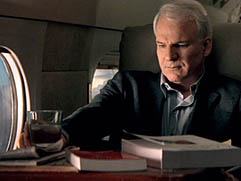Steve Martin’s new novel An Object of Beauty will be released tomorrow.
“The most charmingly rendered female schemer since Truman Capote’s Holly Golightly.”
— Elle magazine
“Martin compresses the wild and crazy end of the millennium
and finds in this piercing novel a sardonic morality tale….
Exposes the sound and fury of the rarified Manhattan art world.”
— Publishers Weekly
“Like Steve Martin’s Shopgirl , this very different novel will captivate your attention from start to finish.”
— Joyce Carol Oates
Martin on his character Ray Porter in the novella Shopgirl (published Oct. 11, 2000)—

“He said, ‘I wrote a piece of code
that they just can’t seem to do without.’
He was a symbolic logician. That was his career….”
As the above review notes, Martin’s new book is about art at the end of the millennium.
See also Art Wars: Geometry as Conceptual Art
and some of my own notes from 2000 (March 9) in “Is Nothing Sacred?”
Some related material —
A paperback with a striking cover (artist unknown)—

Note that the background may be constructed from
any of four distinct motifs. For another approach to these
motifs in a philosophical context, see June 8, 2010.
“Visual forms— lines, colors, proportions, etc.— are just as capable of articulation , i.e. of complex combination, as words. But the laws that govern this sort of articulation are altogether different from the laws of syntax that govern language. The most radical difference is that visual forms are not discursive . They do not present their constituents successively, but simultaneously, so the relations determining a visual structure are grasped in one act of vision.”
– Susanne K. Langer, Philosophy in a New Key





































